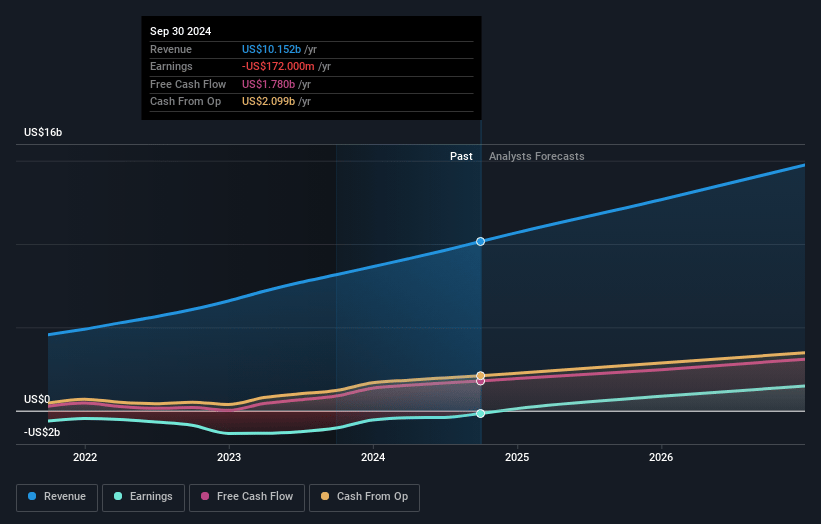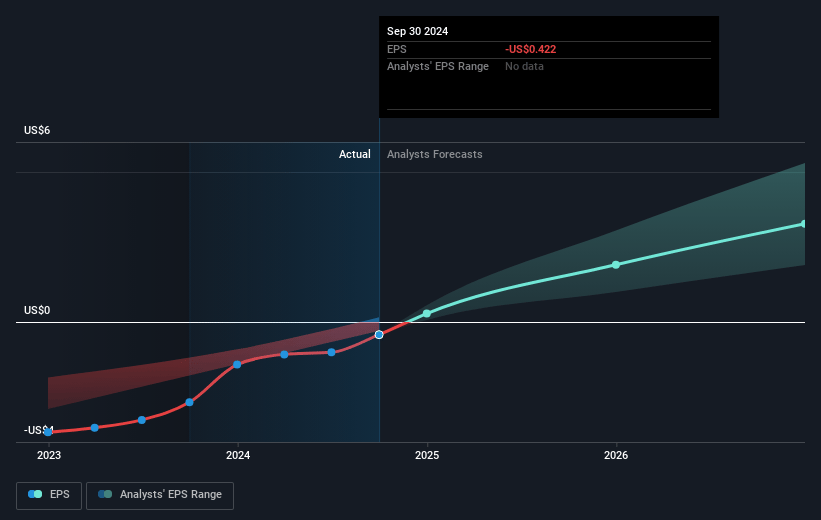Key Takeaways
- Exploring new geographies and retail verticals could drive substantial revenue growth through increased market penetration and order frequency.
- Advancements in technology and scalable advertising enhance operational efficiency and monetization, supporting improvements in profit margins and overall earnings potential.
- The company's heavy investment in technology and international expansion poses both opportunities and risks to short-term profitability and long-term growth potential.
Catalysts
About DoorDash- Operates a commerce platform that connects merchants, consumers, and independent contractors in the United States and internationally.
- DoorDash's significant potential for increasing total addressable market (TAM) penetration and order frequency suggests opportunities for substantial revenue growth as they explore new geographies and enhance product offerings.
- The company expects improvements in contribution margins and overall profit dollars through increased operational efficiency, particularly in international markets where further scaling can enhance gross profitability.
- Expanding into grocery and new retail verticals offers scope for an increase in revenue and long-term earnings, as positive indicators of repeat customer behavior and increased customer spend per month highlight promising engagement metrics.
- Enhancements in technology integration, such as autonomous vehicles and advanced logistics, anticipate reducing operational costs and improving delivery efficiency, positively impacting net margins in the long term.
- The focus on scalable advertising and personalized customer experiences can augment revenue streams and support monetization efforts through targeted interactions, enhancing the overall earnings potential.
DoorDash Future Earnings and Revenue Growth
Assumptions
How have these above catalysts been quantified?- Analysts are assuming DoorDash's revenue will grow by 18.7% annually over the next 3 years.
- Analysts assume that profit margins will increase from 1.1% today to 13.7% in 3 years time.
- Analysts expect earnings to reach $2.4 billion (and earnings per share of $5.3) by about April 2028, up from $123.0 million today. However, there is a considerable amount of disagreement amongst the analysts with the most bullish expecting $3.8 billion in earnings, and the most bearish expecting $1.7 billion.
- In order for the above numbers to justify the analysts price target, the company would need to trade at a PE ratio of 50.7x on those 2028 earnings, down from 623.0x today. This future PE is greater than the current PE for the US Hospitality industry at 23.2x.
- Analysts expect the number of shares outstanding to grow by 2.73% per year for the next 3 years.
- To value all of this in today's terms, we will use a discount rate of 7.61%, as per the Simply Wall St company report.
DoorDash Future Earnings Per Share Growth
Risks
What could happen that would invalidate this narrative?- The company's reliance on forward-looking statements is subject to numerous risks and uncertainties, which could lead to material differences between expected and actual results, potentially impacting earnings and profitability.
- The international markets are in early stages of penetration and profitability, with the company not yet operating in all potential cities and countries, posing risks to scaling efforts and future revenue growth.
- The need for constant product improvement and competition in both new verticals and core areas could lead to increased operational expenses, pressuring net margins and overall profitability.
- Investments in technology, such as autonomous vehicles and AI, present long-term opportunities but also require substantial initial investments and may take time to become profitable, affecting short-term earnings.
- Regulatory and environmental challenges, such as those posed by natural disasters and fluctuating foreign exchange rates, can have unpredictable impacts on operational efficiency and top-line revenue.
Valuation
How have all the factors above been brought together to estimate a fair value?- The analysts have a consensus price target of $219.055 for DoorDash based on their expectations of its future earnings growth, profit margins and other risk factors. However, there is a degree of disagreement amongst analysts, with the most bullish reporting a price target of $250.0, and the most bearish reporting a price target of just $138.27.
- In order for you to agree with the analyst's consensus, you'd need to believe that by 2028, revenues will be $17.9 billion, earnings will come to $2.4 billion, and it would be trading on a PE ratio of 50.7x, assuming you use a discount rate of 7.6%.
- Given the current share price of $182.42, the analyst price target of $219.06 is 16.7% higher.
- We always encourage you to reach your own conclusions though. So sense check these analyst numbers against your own assumptions and expectations based on your understanding of the business and what you believe is probable.
How well do narratives help inform your perspective?
Disclaimer
Warren A.I. is a tool utilizing a Large Language Model (LLM) that ingests data on consensus price targets, forecasted revenue and earnings figures, as well as the transcripts of earnings calls to produce qualitative analysis. The narratives produced by Warren A.I. are general in nature and are based solely on analyst data and publicly-available material published by the respective companies. These scenarios are not indicative of the company's future performance and are exploratory in nature. Simply Wall St has no position in the company(s) mentioned. Simply Wall St may provide the securities issuer or related entities with website advertising services for a fee, on an arm's length basis. These relationships have no impact on the way we conduct our business, the content we host, or how our content is served to users. The price targets and estimates used are consensus data, and do not constitute a recommendation to buy or sell any stock, and they do not take account of your objectives, or your financial situation. Note that Warren A.I.'s analysis may not factor in the latest price-sensitive company announcements or qualitative material.




